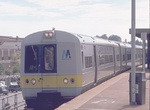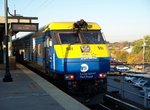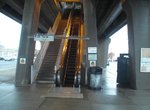LIRR Babylon Line
![]()
LIRR Budd M1/M3 Series train at Babylon. Photo by Salaam Allah, September 2002.
Overview
The Babylon Branch officially begins, appropriately enough, with the electrified portion of the South Shore line at Babylon. We will board our imaginary M-1 train for our westbound journey here.
Babylon station is located in the heart of Babylon Village, at the intersection of Carll and Railroad Avenues. This is an elevated station, with three tracks and two island platforms. The Babylon storage yard is about a half-mile east. The platform canopies are arched and have concrete roofs. There is a large waiting room, finished in light green tile, with a busy ticket window, which is open at 6AM and stays open into the evening. It is also open on weekends. Just outside, escalators lead to and from the platforms. There are also exits further west at Carll Avenue and just east of the main waiting room. A handicapped elevator is just behind the waiting room building. Permit parking is available, and there are metered spaces in the main lot, with daily-fee ($2.50) lots located to the west. An additional commuter lot is a quarter-mile walk to the east. Both Nassau and Suffolk county bus routes terminate here.
All stations between here and Lynbrook have single island platforms.
Lindenhurst is next. Located at Hoffman Ave. and Irmish St., just east of the old ground-level station, it sits on a concrete viaduct. A modern full-length canopy shades the platform. The low walls around the stairways are covered in light green bricks. There is a waiting room, but the ticket office is closed. Parking is in two lots on the nor th side of the tracks.
Next is Copiague. The station is located north of Oak Street at Little Neck Road. It is identical to Lindenhurst, having been built at the same time and by the same builder. There is a small parking lot on the south side of the station. Again, the ticket office is closed, but there is a waiting room. There is a slight curve to the tracks just to the east.
Amityville station is next. Again, identical construction to the stations at Lindenhurst and Copiague. The station is located about two blocks west of Main Street (Route 110), behind the village's main Fire House. Access is via two side streets. Parking lots are on either side of the tracks. About a half-mile to the west are crossover switches.
Massapequa Park station is next, as we leave Suffolk County and enter Nassau. Just before the station, we pass the busy Sunrise Mall on our right and the smaller companion malls across Sunrise Highway on our left. A bell tower graces the entrance to the station parking lot, which sprawls along the north side of Sunrise Highway. The station itself is located at Park Avenue and Sunrise Highway, and, again, features the same architectural design and features as the three previous stations.
The elevated structure turns into an earthen embankment and lowers itself by about fifteen feet. Soon, we find ourselves at Massapequa station, located at the intersection of Broadway and Sunrise Highway. Parking lots spread out to the east of the station, and one can find commuters actually parking along the shoulders of Sunrise Highway once the lots fill up. This station has retained its original platform canopy, and features a wooden roof covered with asphalt. Flourescent light fixtures with grooved shades peek out from under the canopy's eaves. The old-style roof supports remain. The station waiting room is similar to Babylon's inside, with an active ticket window. Mushroom lights, common throughout LIRR stations, adorn the island platform. There is a covered stairway at the west end with a quaint peaked roof.
The concrete viaduct is replaced by earthen embankments and short elevated structures between Massapequa and Wantagh stations, with the tracks rising and falling gently between stations.
Seaford station is next. Located between Jackson and Washington Avenues, just north of Sunrise Highway, this elevated station features an austere design, with cuplights on tall poles illuminating the platform. The platform canopy is simple, with steel I-beams supporting it. The parking lot is attractive, with many trees shading it and grass islands separating the areas.
Wantagh station is located north of Sunrise Highway, which bows to the south, at Railroad Avenue and Wantagh Avenue. It is similar to the Seaford station, with tall light stanchions and a simple platform canopy. Parking immediately adjacent to the station is limited - the main lot is north and east, towards the Fire House.
Bellmore station finds us returning to the Lindenhurst - Copiague - Amityville school of design, with a concrete viaduct and streamlined platform canopy. The station is at Bellmore Avenue and Sunrise Highway and features a large parking lot along the south side. Waiting passengers might get a jolt here courtesy of the Bellmore Volunteer Fire Department's deafening air horn, which is located directly north of the station.
Next is Merrick, which is a cousin to Bellmore, but features a shorter platform canopy, with mushroom lights at the open east end. Located at Merrick Avenue and Sunrise Highway, it also features a sizeable parking lot along its south flank.
We then slow down approaching the Freeport station due to a large number of switches and turnouts for the Freeport layup yard. The station itself is located in the heart of downtown, north of Sunrise High way at Henry Street. It features early 1960s design, with "Whiteway" flourescent lights. There is a brick waiting room structure at platform level, along with arched sections between the canopy supports. The waiting room is typical of the period - green brick inside and square lights set flush with the ceiling. Buses to Jones Beach terminate here during the summer. A number of parking lots spread out to the south and east, and there are also local bus transfers.
Baldwin station is next. It is similar to Massapequa station, except the platform canopy only covers part of the platform. The mushroom lights are very prominent. The station is just east of Grand Avenue, at Sunrise Highway, in the center of town. A covered stairway leads from the west end of the platform to Grand Avenue below. The elevated structure is lower than that at Freeport.
Rockville Centre station, located between Village and Clinton Avenues, comes next. Opened in July 1950, this concrete station is similar to Babylon, and features the same squared canopy with arches. Directly to the north is the imposing St. Agnes Cathedral, seat of the Rockville Centre Diocese, with its 150-foot-plus spires. There is metered parking to the south and east, and Park Avenue, with its trendy restaurants, is right nearby.
Normally, Babylon Branch trains go straight to Jamaica from here. However, you will get an occasional train to stop at Lynbrook station, located at Atlantic Avenue just north of Sunrise Highway. This station is the transfer point to the Long Beach Branch. It has four tracks and two island platforms, and is decked out smartly in shades of blue with white accents. Aluminum-clad canopies shade the platforms, bearing the same blue and white colors. The station sits on a concrete elevated structure, and was raised in the 1950s.
We now proceed straight to Jamaica to continue our trip.
Photo Gallery
| Five Random Images | ||||
 Image 45615 (94k, 768x512) Photo by: Eric Oszustowicz Collection of: Joe Testagrose Location: Babylon |  Image 60384 (187k, 1024x685) Photo by: Pete Donner Collection of: Joe Testagrose Location: Wantagh |  Image 93002 (207k, 1044x788) Photo by: Chris Reidy Location: Babylon |  Image 108245 (250k, 1044x788) Photo by: Roberto C. Tobar Location: Lindenhurst |  Image 162016 (280k, 1220x920) Photo by: Roberto C. Tobar Location: Massapequa Park |
Photos By Location
Photo locations: Lynbrook, Rockville Center, Baldwin, Freeport, Merrick, Bellmore, Wantagh, West of Wantagh, Seaford, Massapequa, Massapequa Park, Amityville, Copiague, Lindenhurst, Babylon
Page Credits
By Wayne Whitehorne.